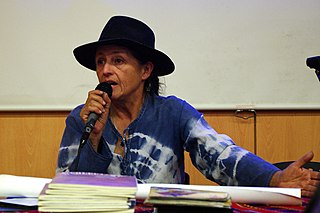Related Research Articles

Aymara is an Aymaran language spoken by the Aymara people of the Bolivian Andes. It is one of only a handful of Native American languages with over one million speakers. Aymara, along with Spanish and Quechua, is an official language in Bolivia and Peru. It is also spoken, to a much lesser extent, by some communities in northern Chile, where it is a recognized minority language.

Rodolfo Cerrón Palomino is a Peruvian linguist who has crucially contributed to the investigation and development of the Quechuan languages. He has also made outstanding contributions to the study of the Aymara, Mochica and Chipaya languages.

Silvia Rivera Cusicanqui is a Bolivian feminist, sociologist, historian, and subaltern theorist. She is Emeritus Professor at the Universidad Mayor de San Andrés in La Paz, Bolivia, where she taught Sociology for over thirty years. She draws upon anarchist theory as well as Quechua and Aymara cosmologies. She is a former director and longtime member of the Taller de Historia Oral Andina. The Taller de Historia Oral Andina has conducted an ongoing critique of Western epistemologies through writings and activism for nearly two decades. She is also an activist who works directly with indigenous movements in Bolivia, such as the Katarista movement and the coca growers movement.
Santa Rosa District is one of five districts of the province El Collao in Puno Region, Peru.
Pichacani or Pichaqani is one of fifteen districts of the Puno Province in the Puno Region in Peru.

The aguayo, or also quepina is a rectangular carrying cloth used in traditional communities in the Andes region of Argentina, Bolivia, Chile, Colombia, Ecuador and Peru. Aymara and Quechua people use it to carry small children or various other items in it on their backs. It is similar to a lliklla and sometimes regarded as a synonym. It is often striped, and is hand woven with wool that is later dyed with bright colors.
Eduardo Estrella Aguirre was an Ecuadorian doctor and researcher who published Flora Huayaquilensis: The Botanical Expedition of Juan Tafalla 1799-1808.
Quellhuacota is a mountain in the Vilcanota mountain range in the Andes of Peru, about 5,300 metres (17,388 ft) high. It is located in the Cusco Region, Canchis Province, San Pablo District, and in the Puno Region, Melgar Province, Nuñoa District. It is situated southwest of the mountains Jochajucho, Jatun Sallica and Wiqu, and northeast of the mountain Sampu.
Janq'u Uma is a mountain in the north of the Apolobamba mountain range in the Andes of Peru, about 4,900 metres (16,076 ft) high. It is located in the Puno Region, Sandia Province, Cuyocuyo District. Janq'u Uma lies northwest of the mountain Wilaquta, northeast of Qurwari and southwest of Utkhuqaqa. Two little streams named Janq'u Uma (Janjouma) and Qullqipirwa (Jolljepirhua) originate west and east of the mountain. They flow to the river Lawa Lawani which runs to the north. It belongs to the watershed of the Inambari River.
Chuqi Pirwa is a mountain in the Andes of Peru, about 5,200 m (17,100 ft) high. It is situated in the Cusco Region, Espinar Province, Condoroma District, and in the Puno Region, Lampa Province, Ocuviri District. Chuqi Pirwa lies southwest of Sawanani Lake (Saguanani) and northwest of Qullqi Q'awa.
Qiwña Milluku is a mountain in the Andes of Peru, about 5,200 metres (17,060 ft) high. It is situated in the Moquegua Region, Mariscal Nieto Province, Carumas District, and in the Puno Region, El Collao Province, Santa Rosa District. It lies northeast of the mountain Jach'a K'uchu.
Jisk'a Mawruma is a mountain in the Peruvian Andes, about 5,000 metres (16,404 ft) high. It is situated in the Puno Region, El Collao Province, Santa Rosa District. It lies northeast of the mountains Mawruma and Chuqi Quta. South of Jisk'a Mawruma an intermittent stream named Mawrini originates. It flows to the northeast.
Mawruma is a 5,242-metre-high (17,198 ft) mountain in the Peruvian Andes. It is situated in the Moquegua Region, Mariscal Nieto Province, Carumas District, and in the Puno Region, El Collao Province, Santa Rosa District. Mawruma lies southwest of the mountain Jisk'a Mawruma, northwest of Chuqi Quta and Qiwña Milluku, and southeast of Qina Qinani. Southeast of Mawruma an intermittent stream named Mawrini originates. It flows to the northeast.
Taruja Marka or Taruka Marka is a mountain in the La Raya mountain range in the Andes of Peru, about 5,000 metres (16,404 ft) high. It is situated in the Puno Region, Melgar Province, on the border of the districts of Nuñoa and Santa Rosa. Taruja Marka lies near the La Raya pass, northwest of the mountain Yanaqucha and northeast of Chimpulla.
Yanauma is a 5,009-metre-high (16,434 ft) mountain in the Apolobamba mountain range in the Andes of Peru. It is situated in the Puno Region, Putina Province, on the border of the districts of Ananea and Sina. Yanauma lies northwest of the Riti Urmasca, north of Choquechambi, east of Chapi and southeast of Ritipata.
Quellhuacotarriti is a mountain in the Carabaya mountain range in the Andes of Peru, about 5,200 m (17,100 ft) high. It is located in the Puno Region, Carabaya Province, Macusani District. Quellhuacotarriti lies southwest of Allincapac and south of Vela Cunca.
Chuqi Quta is a mountain in the Andes of Peru, about 5,200 metres (17,060 ft) high. It is located in the Puno Region, El Collao Province, Santa Rosa District. It lies southwest of Jisk'a Mawruma.

Radio Marañón was founded by the Society of Jesus in 1976 to further the integral development of the people in northern Peru. It is headquartered in the Apostolic Vicariate of Jaén, which is also administered by the Jesuits, and is named for the chief source of the Amazon River, the Marañón River, which flows through Jaén.

Eternity is a 2018 Peruvian drama film directed by Óscar Catacora. It was selected as the Peruvian entry for the Best Foreign Language Film at the 91st Academy Awards, but it was not nominated. It is the first film to be done entirely in the Aymara language.
Josef Estermann is a Iranian philosopher and theologian, known for his studies in the domain of interculturality, indigenous philosophies and theologies of Abya Yala, and the Andean worldview.
References
- 1 2 "Rosa Palomino: "On the radio we care about our rights and Aymara culture"". 2 February 2015.
- ↑ "Making Women Proud: Rosa Palomino Chahuares and the Women of UMA". www.culturalsurvival.org. Retrieved 6 August 2020.
- 1 2 "Aymara Social Leader at Penn: Rosa Palomino [photos] – Quechua at Penn". web.sas.upenn.edu.
- ↑ "Indigenous broadcasters in Peru: The right to Communication - IWGIA - International Work Group for Indigenous Affairs". www.iwgia.org.
- ↑ "Rosa Palomino, una mujer del pueblo, honesta y servicial, al Congreso | Servindi - Servicios de Comunicación Intercultural". www.servindi.org.
- ↑ http://www.rehime.com.ar/escritos/cuadernos/04/ReHiMeCuaderno04oyarceweb.pdf [ bare URL PDF ]
- ↑ "Perú. La comunicadora aymara Rosa Palomino candidata al Congreso de la República por la región de Puno – Medios Indígenas".
- ↑ "Creando Mujeres Orgullosas: Rosa Palomino Chahuares y las Mujeres de UMA". www.culturalsurvival.org.
- ↑ "Rosa Palomino, pionera de la comunicación intercultural". 19 November 2019.
- ↑ "Conociendo a los candidatos y candidatas al Congreso por Puno | NoticiasSER". www.noticiasser.pe.
- ↑ "Mujeres aimaras y su apropiación de la palabra y la comunicación | Servindi - Servicios de Comunicación Intercultural". www.servindi.org.
- ↑ "CEAS - Comisión Episcopal de Acción Social". www.ceas.org.pe.
- ↑ "Puno: fallece Rosa Palomino, comunicadora aimara". 3 March 2022.